Organize your fragrance testers in three easy steps. First, select a cool, dark area and set up clear storage containers or zip-top bags for different scent categories. Next, label everything clearly using a label maker or fine-tipped marker, placing tags at eye level for quick identification. Finally, arrange testers by brand or fragrance family, using tiered displays for visibility. These basics will help you build an efficient system that'll enhance your fragrance journey.
Essential Tools for Tester Organization
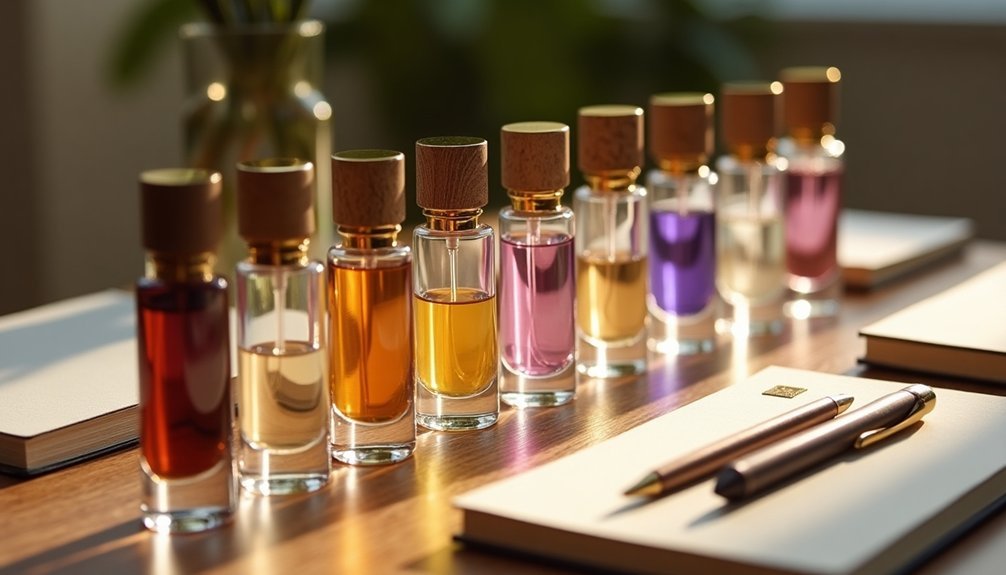
Organization becomes effortless when you have the right tools for managing fragrance testers.
Finding the perfect organizational tools transforms fragrance tester management from a chore into a seamless experience.
You'll need clear storage bins that let you quickly spot your perfume samples while keeping them protected. Small zip top bags, arranged alphabetically, create an efficient organization system that prevents confusion and saves time during selection.
For a space-saving solution, consider ammunition boxes or acrylic lipstick stands that offer tiered storage, making it easy to access your collection.
Spice racks with multiple levels work perfectly for displaying testers while maximizing vertical space.
Don't overlook everyday items that can be repurposed – protein powder containers and old jewelry boxes make excellent storage alternatives.
These versatile options help you create a personalized setup that keeps your fragrance testers neat and accessible.
Creating Your Sorting Space
Selecting the perfect spot for your fragrance sorting station sets the foundation for an efficient organization system. Choose a dedicated area in your home, like a desk or shelf, that's well-lit and maintains a cool temperature to protect your testers from deterioration.
Your sorting space should include clear containers or bags to separate different fragrance categories, making it simple to locate specific scents when you need them.
To maximize visibility and create an effective organization method, consider using tiered storage solutions such as spice racks or cake stands.
Don't forget to keep a notepad or digital device within reach to record your impressions of each fragrance as you sort. This systematic approach will help you maintain an organized collection that's both accessible and properly preserved.
Proper Labeling Techniques
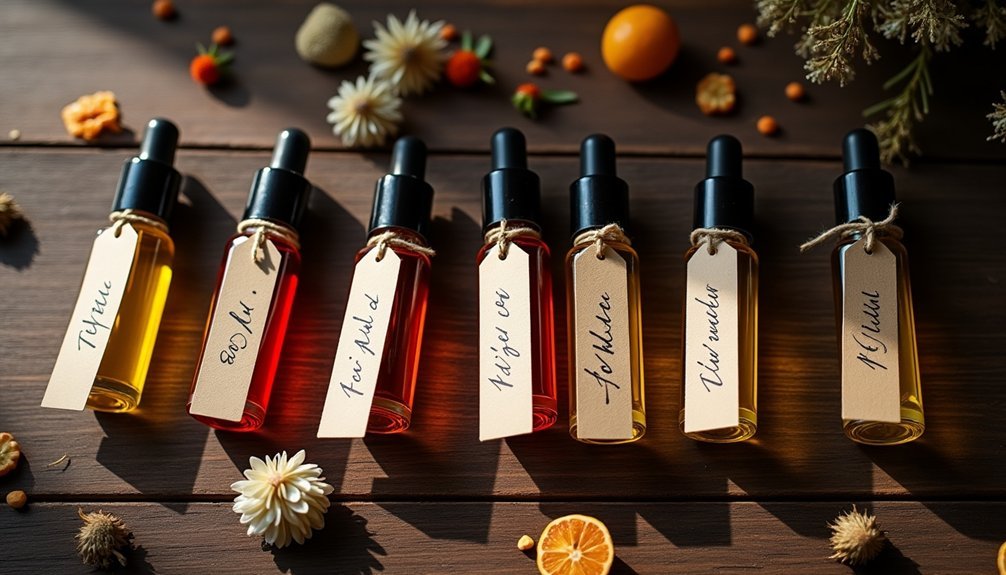
Start with a label maker to create crisp, professional tags that you'll place prominently on each fragrance tester's container.
You'll want to position labels consistently at eye level on the front of each bottle, making them easily readable when browsing your collection.
For handwritten labels, opt for fine-tipped permanent markers that won't smudge, and always write clearly in block letters to guarantee long-term legibility.
Clear Label Placement Methods
Proper label placement transforms a chaotic fragrance collection into an orderly, accessible system. When you organize your testers, place labels on the top of each bottle where they're easily visible during storage. You'll want to arrange them alphabetically or by category, making quick access a breeze.
- Use a high-quality label maker to create durable, legible tags that won't fade
- Place labels consistently on bottle tops for immediate visibility
- Color-code your labels based on scent families for intuitive organization
- Keep labels updated as your collection changes
- Maintain alphabetical order or category groupings for efficient retrieval
Remember to regularly check your labels for wear and tear, replacing them as needed.
This systematic approach guarantees you'll always find the right fragrance tester when you need it, saving time and frustration in your fragrance management routine.
Best Label Writing Tools
Three essential tools make fragrance tester labeling both efficient and professional. Your primary choice should be a label maker, which creates clear, uniform text that enhances your organization system.
If you prefer a personal touch, opt for permanent markers on label tape, guaranteeing your handwritten labels remain durable and easy to read.
For advanced organization, consider using color-coded labels to sort your collection by scent families or brands.
Whichever tool you choose, maintain consistency in your format by including key details like the fragrance name, brand, and purchase date.
You'll want to keep the font size and style uniform when using a label maker, or maintain similar handwriting styles if you're writing manually.
This systematic approach guarantees your labels remain professional and functional.
Storage Solutions for Different Strip Types
Effective fragrance strip storage requires different solutions based on the variety of samples in your collection.
You'll want to organize your samples strategically, using storage solutions that maximize accessibility while protecting your valuable testers. Sort your carded samples into smaller boxes, keeping mainstream and niche brands separate, while using zip-top bags for loose samples grouped by fragrance family.
- Create a tiered display using repurposed acrylic stands for easy visibility
- Separate larger decants into categorized containers for quick access
- Use labeled boxes to distinguish between different sample sizes
- Group loose samples in zip-top bags by scent type (vintage, fruity, citrus)
- Store carded samples in divided boxes, organizing by brand category
This systematic approach helps you maintain an organized collection while ensuring each sample type remains easily accessible.
Categorizing Scent Families
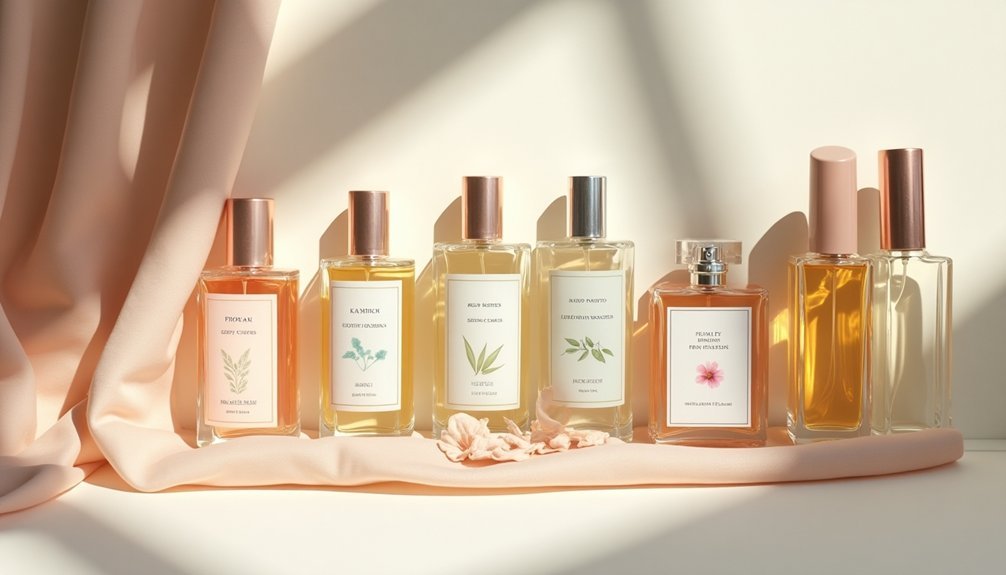
With your storage systems in place, organizing your fragrance testers by scent family creates a logical next step in perfume management. You'll find it easier to organize your perfume collection when you group similar fragrances together, allowing quick access for testing and comparison.
| Family | Characteristics | Perfect For |
|---|---|---|
| Floral | Sweet, romantic | Spring dates |
| Citrus | Fresh, zesty | Summer days |
| Woody | Warm, earthy | Fall evenings |
| Oriental | Rich, exotic | Winter nights |
Maintaining Test Strip Freshness
You'll maximize your test strips' effectiveness by storing them in cool, dark places using airtight containers or zip-top bags to prevent scent degradation.
Keep your testers protected from direct sunlight and UV exposure, which can quickly break down fragrance compounds and alter their intended scents.
Organize your test strips by scent family or brand, and rotate your stock regularly to guarantee older samples get used first, maintaining the overall freshness of your collection.
Proper Storage Methods
Maintaining the quality of fragrance testers requires proper storage techniques that protect their delicate scent profiles. Your samples and decants need a cool, dark environment to preserve their integrity.
Use airtight plastic containers to shield them from air exposure, which can compromise their authentic scents. You'll want to establish a system that keeps your collection organized while maximizing its longevity.
- Store all testers away from windows and heating vents
- Place containers in a dedicated drawer or cabinet
- Label each container with the opening date
- Check your collection monthly for any signs of deterioration
- Keep storage temperatures consistently cool
Remember to discard any testers that show significant changes in scent or appearance.
Tester Longevity Tips
Because fragrance test strips can quickly lose their scent integrity, proper preservation techniques are vital for accurate sampling. To maximize your tester longevity tips and maintain your perfume collection's freshness, store your samples in airtight containers away from light and heat. You'll want to keep them in a cool, dark place and avoid humid environments like bathrooms.
| Storage Factor | Impact on Longevity |
|---|---|
| Temperature | Cool preserves, heat destroys |
| Light Exposure | Darkness protects, UV damages |
| Air Contact | Sealed extends, open diminishes |
| Humidity | Dry maintains, moisture degrades |
| Time | Fresh within 6 months, atomizers 2-3 years |
Don't forget to label and date your testers immediately. This simple practice helps you track their age and guarantees you'll use them before they expire, maintaining the integrity of your fragrance testing experience.
Time-Based Testing Methods
Fragrance testing requires a methodical approach to truly understand how a scent develops over time. When you're ready to begin time-based testing, arrange your fragrance bottles and mark specific intervals: 15 minutes, 1 hour, and 4 hours.
Apply the scent directly to your skin rather than paper strips, as your natural body chemistry will interact with the fragrance to create its true character.
- Keep a notebook or digital app handy to record your impressions
- Test the initial top notes during the first 15 minutes
- Check how the heart notes develop after one hour
- Return to assess the base notes at the 4-hour mark
- Document unexpected scent changes throughout the day
This systematic approach will help you discover which fragrances truly complement your style and maintain their appeal throughout wear time.
Documenting Fragrance Notes
You'll find both digital and paper methods effective for tracking your fragrance testing experiences.
Digital note-taking apps and spreadsheets offer searchable databases where you can quickly filter and compare different scents, while organizing photos and performance details in one accessible place.
Traditional paper journals or cards provide a tactile experience and allow for quick sketches or personalized scent wheels, making them particularly useful during in-store sampling sessions.
Digital Note Taking Methods
When exploring the world of fragrances, keeping detailed digital notes can transform your sampling experience into a well-documented journey.
Digital note-taking methods offer versatile ways to track your fragrance notes and impressions. You'll find apps like Evernote and Notion particularly useful for organizing your scent discoveries, while spreadsheets can help you compare different perfumes systematically.
- Use mobile apps like OneNote for quick, on-the-spot impressions when testing fragrances
- Create dedicated spreadsheets to track wear duration and scent profiles
- Capture photos of fragrance bottles to enhance your digital records
- Include links to online reviews for additional reference
- Update your notes regularly to maintain a thorough collection of your fragrance experiences
These digital tools guarantee you'll always have your fragrance insights at your fingertips, making future purchases and sampling decisions more informed and enjoyable.
Paper Tracking Systems
Although digital tools offer modern convenience, a well-maintained paper tracking system provides a tactile and intimate way to document your fragrance journey.
Create a dedicated notebook where you'll organize your fragrance notes using a standardized format for each scent you test. For each fragrance, allocate a full page and include essential details like the brand name, specific scent notes, and your personal rating.
You'll want to note the testing date and record your initial impressions of the fragrance, along with observations about its longevity. This paper tracking system lets you monitor how your preferences evolve over time and builds a valuable reference collection.
You can easily share these documented experiences with other fragrance enthusiasts or revisit them to understand your developing scent preferences better.
Environmental Factors for Testing
Maintaining the perfect environment for fragrance testers is essential to preserve their authentic scents and extend their shelf life. Your fragrance testers need protection from environmental factors that can compromise their quality.
Keep them in a cool, dark storage area away from bathrooms and spaces with temperature fluctuations. You'll want to monitor humidity levels and guarantee tight sealing of containers to prevent unwanted evaporation.
- Store testers in a cool, dark place to prevent heat and light damage
- Choose low-humidity areas to protect scent integrity
- Avoid bathroom storage where temperatures often fluctuate
- Keep all containers tightly sealed when not in use
- Check regularly for color changes or scent alterations that signal degradation
Remember to inspect your testers periodically for any signs of deterioration, confirming they remain in prime condition for accurate testing.
Organizing Multiple Scent Trials
To maximize your fragrance testing experience, organizing multiple scent trials requires a systematic approach that prevents sensory overload.
Start by grouping your testers into distinct scent families like floral, woody, and citrus. This categorization will help you navigate through your collection efficiently during testing sessions.
Create a practical organizing system by using labeled containers or small bags for each fragrance category. You'll want to store these in a cool, dark place to protect the scents from deterioration.
For quick reference, arrange your testers alphabetically by brand or fragrance name. When you're unsure about certain scents, place them in a designated "purgatory basket" for later evaluation.
This method lets you maintain focus on your current testing priorities while keeping track of fragrances you'll want to revisit.
Cross-Referencing Systems for Results
Creating an effective cross-referencing system transforms how you track and analyze your fragrance collection. You'll need to assign unique identifiers to your perfume bottles and record essential details in a spreadsheet or database. This organized approach helps you quickly find specific scents and compare different fragrances based on their characteristics.
- Label each tester with a unique code that links to your digital catalog
- Record brand names, scent categories, and personal ratings in your database
- Create visual maps showing connections between similar fragrance families
- Track purchase dates and testing notes for each scent
- Update your cross-referencing system regularly as your collection changes
Frequently Asked Questions
What Is the 30 50 20 Rule for Perfume?
You'll want to divide your perfume collection into three categories: 30% fresh scents for daytime, 50% warm and floral fragrances for versatility, and 20% deep, rich scents for evening wear or special occasions.
How to Sort Perfume Samples?
You'll want to sort your perfume samples by scent families like floral, citrus, and woody. Use clear containers, label everything, and organize alphabetically. Keep a separate box for samples you're unsure about.
What Are the 3 Main Notes of Every Fragrance?
You'll find three main notes in every fragrance: top notes that hit you first but fade quickly, middle notes that form the fragrance's heart, and long-lasting base notes that provide depth and richness.
How Do You Use a Fragrance Tester?
Spray the tester on your pulse points like wrists and neck. Let it settle for a few minutes to reveal the true scent. You'll want to experience how it develops throughout the day.
In Summary
You've now got all the tools to create an organized fragrance testing system that'll serve you well. By following these three steps – setting up your workspace, properly labeling your testers, and maintaining consistent storage conditions – you'll save time and get more accurate results. Don't forget to document your findings and keep your categories clear. Your new system will make future fragrance testing a breeze.
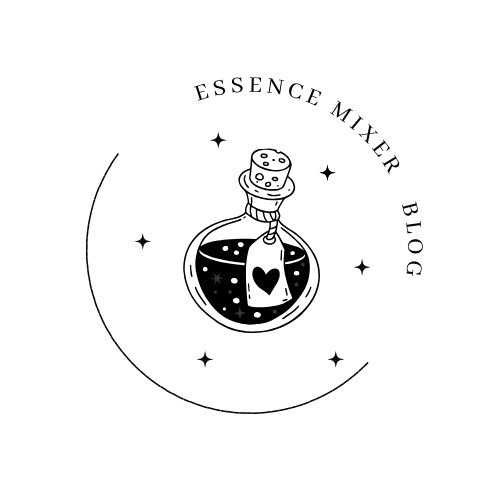
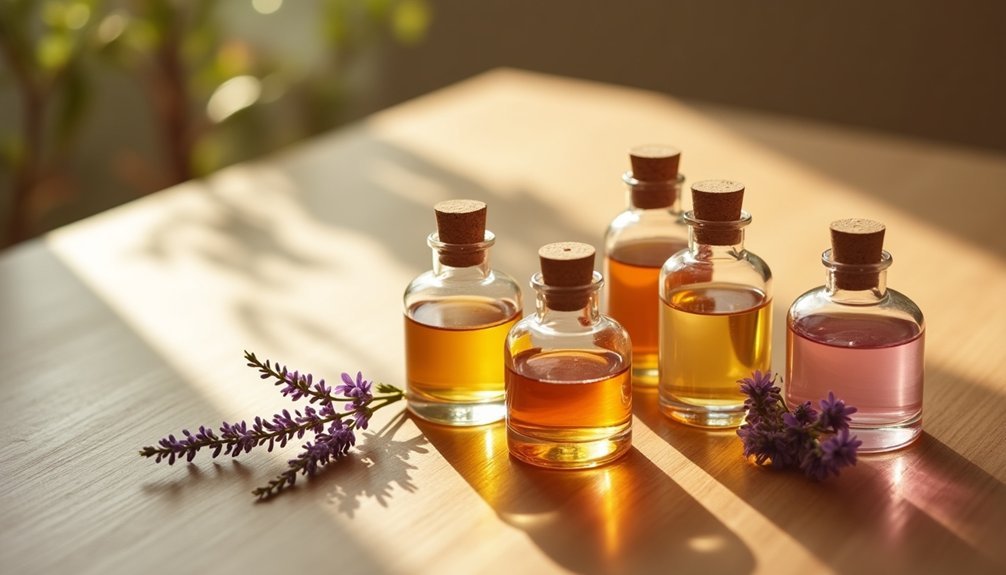



Leave a Reply